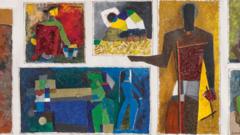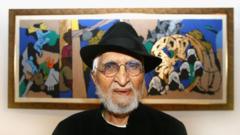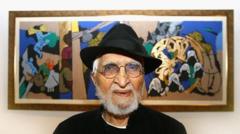A forgotten masterpiece of Indian art has emerged from obscurity, propelling Indian painter MF Husain into the spotlight once again.
Rediscovered Masterpiece Shatters Records in Indian Art History

Rediscovered Masterpiece Shatters Records in Indian Art History
A renowned painting by MF Husain sells for record-breaking $13.8 million at Christie's auction.
A recently discovered oil painting by iconic Indian artist MF Husain has made headlines by achieving an extraordinary sale price of $13.8 million (£10.6 million) at a Christie's auction in New York. The artwork, titled Untitled (Gram Yatra), has decisively altered the landscape of Indian art history, surpassing the previous record of $7.4 million (£5.7 million) set by Amrita Sher-Gil's piece, The Story Teller, earlier this year.
Husain, who passed away in 2011 at the age of 95, was a prominent figure in Indian modernism, influencing countless artists across generations. The artist previously fled India in 2006 following death threats from extremist groups over his depictions of religious icons. For nearly half a century, his groundbreaking painting resided quietly in a Norwegian hospital, largely unnoticed and unappreciated.
Created in 1954, Gram Yatra, depicting themes of village life, is a vibrant mural measuring 14 feet in width, capturing 13 vignettes that showcase the rich tapestry of rural India. Husain's unique integration of folk and modernist influences highlights narrative techniques reminiscent of Indian miniature art, where visual storytelling flourishes.
"Gram Yatra is truly a defining masterpiece of modern South Asian art," remarked Nishad Avari, head of South Asian Modern and Contemporary Art at Christie's. He noted the profound impact of Husain's travels abroad, particularly his trip to China in 1952, which introduced him to the influence of calligraphic brushwork evident within the painting's dynamic strokes.
Post-Indian independence, Husain sought inspiration in rural India, championing the belief espoused by Mahatma Gandhi that the nation’s essence lies within its villages. The art world's discovery of this emblematic painting serves as a testament to how Husain's reflections on India's cultural heritage influenced national identity and urban perspectives.
Husain also pioneered a modified cubist style, evident in this piece, with its pronounced geometric shapes and bold lines. The journey of Gram Yatra, purchased in 1954 for a mere $295 by Ukrainian doctor Leon Elias Volodarsky during his work with the WHO, adds to the painting's mystique. Unbeknownst to the art community, it graced the walls of Oslo University Hospital for almost fifty years before being recognized and eventually auctioned off by Christie's in 2013.
According to Ashish Anand from the Delhi Art Gallery, this landmark sale is set to elevate the value of Husain's body of work, positioning Indian art as a significant financial investment beyond mere aesthetics in the global market.





















